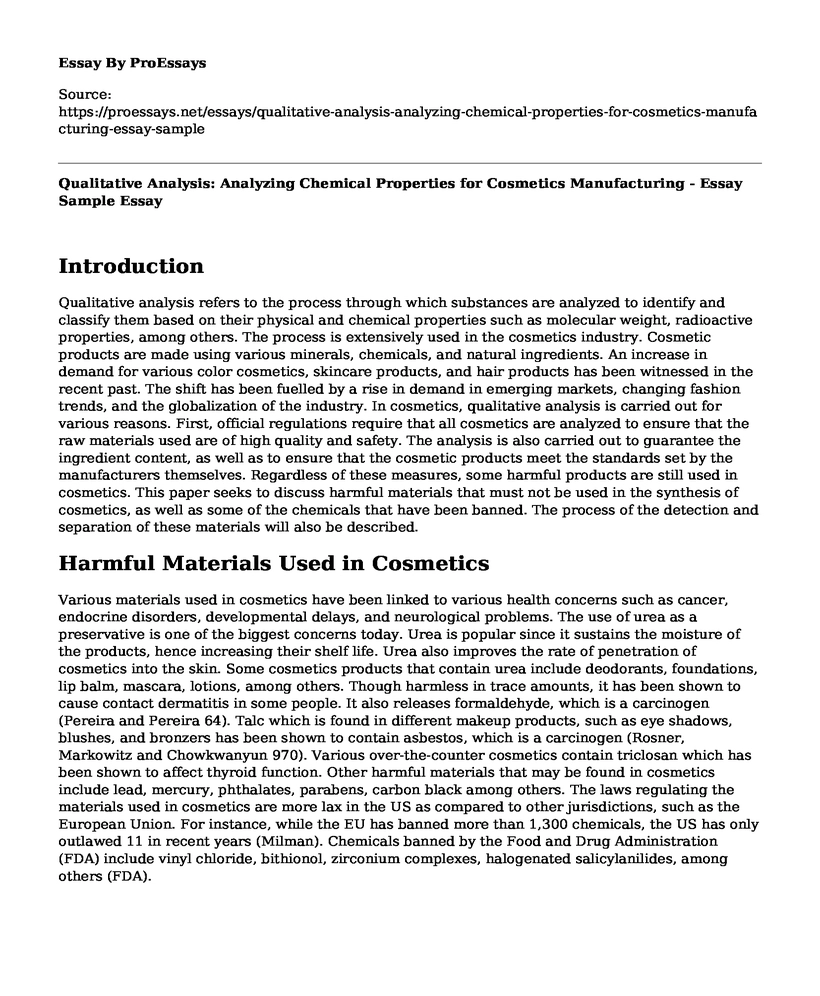Introduction
Qualitative analysis refers to the process through which substances are analyzed to identify and classify them based on their physical and chemical properties such as molecular weight, radioactive properties, among others. The process is extensively used in the cosmetics industry. Cosmetic products are made using various minerals, chemicals, and natural ingredients. An increase in demand for various color cosmetics, skincare products, and hair products has been witnessed in the recent past. The shift has been fuelled by a rise in demand in emerging markets, changing fashion trends, and the globalization of the industry. In cosmetics, qualitative analysis is carried out for various reasons. First, official regulations require that all cosmetics are analyzed to ensure that the raw materials used are of high quality and safety. The analysis is also carried out to guarantee the ingredient content, as well as to ensure that the cosmetic products meet the standards set by the manufacturers themselves. Regardless of these measures, some harmful products are still used in cosmetics. This paper seeks to discuss harmful materials that must not be used in the synthesis of cosmetics, as well as some of the chemicals that have been banned. The process of the detection and separation of these materials will also be described.
Harmful Materials Used in Cosmetics
Various materials used in cosmetics have been linked to various health concerns such as cancer, endocrine disorders, developmental delays, and neurological problems. The use of urea as a preservative is one of the biggest concerns today. Urea is popular since it sustains the moisture of the products, hence increasing their shelf life. Urea also improves the rate of penetration of cosmetics into the skin. Some cosmetics products that contain urea include deodorants, foundations, lip balm, mascara, lotions, among others. Though harmless in trace amounts, it has been shown to cause contact dermatitis in some people. It also releases formaldehyde, which is a carcinogen (Pereira and Pereira 64). Talc which is found in different makeup products, such as eye shadows, blushes, and bronzers has been shown to contain asbestos, which is a carcinogen (Rosner, Markowitz and Chowkwanyun 970). Various over-the-counter cosmetics contain triclosan which has been shown to affect thyroid function. Other harmful materials that may be found in cosmetics include lead, mercury, phthalates, parabens, carbon black among others. The laws regulating the materials used in cosmetics are more lax in the US as compared to other jurisdictions, such as the European Union. For instance, while the EU has banned more than 1,300 chemicals, the US has only outlawed 11 in recent years (Milman). Chemicals banned by the Food and Drug Administration (FDA) include vinyl chloride, bithionol, zirconium complexes, halogenated salicylanilides, among others (FDA).
Detection and Separation of Harmful Materials
Spectrophotometric determination is the most commonly used method in the detection of harmful materials in cosmetics (Esteki, Nouroozi and Shahsavari 26). The method involves the use of spectrophotometers which offer a sensitive, rapid, and cheap means of analysis. Simple water is used as the soluble base hence avoiding the use of other harmful substances in the analysis. Other than detecting toxins, the method can also be used to detect the presence of other impurities in cosmetics. The method is based on the principle that a compound absorbs or transmits light over a particular wavelength. A beam of light is passed through a sample solution and the amount of light absorbed or transmitted is used to determine the specific products in the solution.
Conclusion
While the demand for cosmetics has been on the rise in recent years, concerns over the presence of harmful materials in the products persist. Some of these products include urea, lead, parabens, among others. The materials are used to achieve various purposes such as to increase shelf life and enhance penetration. Though the US regulations are generally considered lax, several chemicals, such as zirconium complexes and halogenated salicylanilides, are banned in the country. Spectrophotometric analysis is one of the most commonly used methods in the detection and classification of these materials.
Works Cited
Esteki, M., S. Nouroozi and Z. Shahsavari. "A fast and direct spectrophotometric method for the simultaneous determination of methyl paraben and hydroquinone in cosmetic products using successive projections algorithm." International journal of cosmetic science 38.1 (2016): 25-34. <https://onlinelibrary.wiley.com/doi/abs/10.1111/ics.12241>.
FDA. "Cosmetics Safety Q&A: Prohibited Ingredients." 22 February 2018. FDA. 11 February 2020. <https://www.fda.gov/cosmetics/resources-consumers-cosmetics/cosmetics-safety-qa-prohibited-ingredients>.
Milman, Oliver. "US cosmetics are full of chemicals banned by Europe - why?" 22 May 2019. The Gurdian. 11 February 2020. <https://www.theguardian.com/us-news/2019/may/22/chemicals-in-cosmetics-us-restricted-eu>.
Pereira, Jonathas Xavier and Thais Canuto Pereira. "Cosmetics and its health risks." Global Journal of Medical Research 18 (2018): 63-66. <https://pdfs.semanticscholar.org/5ee2/f0e6ba6f311c116fdfcefebf0f9aed3a8605.pdf>.
Rosner, David, Gerald Markowitz and Merlin Chowkwanyun. "Nondetected": The Politics of Measurement of Asbestos in Talc, 1971-1976." American journal of public health 109.7 (2019): 969-974. <https://ajph.aphapublications.org/doi/abs/10.2105/AJPH.2019.305085>.
Cite this page
Qualitative Analysis: Analyzing Chemical Properties for Cosmetics Manufacturing - Essay Sample. (2023, Apr 04). Retrieved from https://proessays.net/essays/qualitative-analysis-analyzing-chemical-properties-for-cosmetics-manufacturing-essay-sample
If you are the original author of this essay and no longer wish to have it published on the ProEssays website, please click below to request its removal:
- How Medical Marijuana Operates in Chemotherapy Patients? - Paper Example
- Hypertension Paper Example
- Essay Example on Health Information Technology (HIT): Maximizing Quality Improvement
- Essay Sample on 3 Sections of the Brain: Cerebrum, Brain Stem, & Cranial Nerves
- Paper Sample: Surprising Disease Outbreaks Spark Dream to Become a Pharmaceutical Scientist
- Paper on Plague Personification: Symbolism, Resilience, and Religious Reflections in Literature and Mytholog
- Essay Sample on Effects of COVID-19 Lockdown







